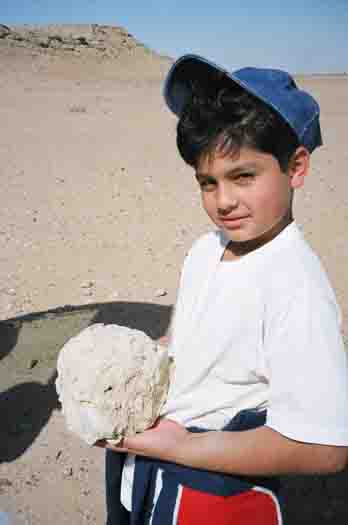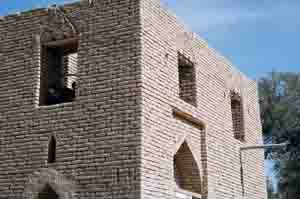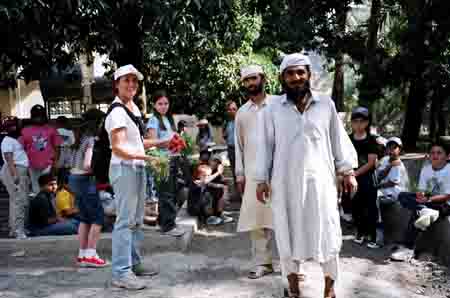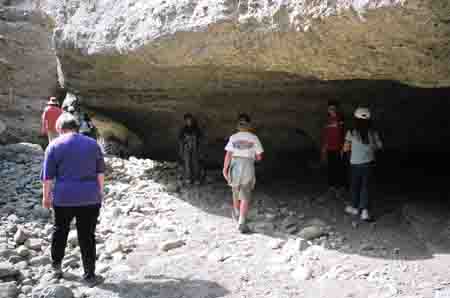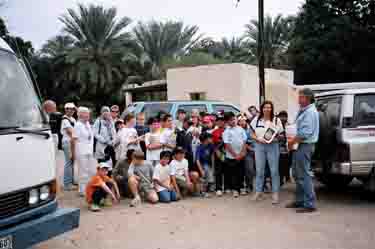|
Under
the Patronage of H.E. Sheikh Nahayan Mubarak Al Nahayan
|
The
Emirates Natural History Group, Al Ain Chapter, PO Box
18057, Al Ain
January, 2005– Issue #224 |
|
Happy
New Year !
100 Years ago…
Maybe this will boggle your mind, I know it did mine! The
year is 1904, one hundred years ago. What a difference a century
makes! Here are some of the US statistics for 1904:
The average life expectancy in the US was 47 years. The maximum
speed limit in most cities was 10 mph.
Only 14% of the homes in the US had a bathtub. Only 8%of
the homes had a telephone.
A three-minute call from Denver to New York City cost $11.00
There was no Mother's Day or Father's Day.
There were only 8,000 cars in the US, and only 144 miles
of paved roads.
Alabama, Mississippi, Iowa, and Tennessee were each more heavily
populated than California. With a mere 1.4 million residents,
California was only the 21st most populous state in the Union.
The tallest structure in the world was the Eiffel Tower.
The population of Las Vegas, Nevada, was 30!
The average wage in the US was 22 cents an hour. The average
US worker made $200 and $400 per year.
A competent accountant could expect to earn $2000 per year,
a dentist $2,500 per year.
A veterinarian between $1,500 and $4,000 per year. A mechanical
engineer about $5,000 per year.
Ninety % of all US physicians had no college education. Instead,
they attended medical schools, many of which were condemned
in the press and by the government as "substandard."
Sugar cost four cents a pound. Eggs were fourteen cents a
dozen. Coffee was fifteen cents a pound.
Most women only washed their hair once a month, and used
borax or egg yolks for shampoo.
Canada passed a law prohibiting poor people from entering
the country for any reason.
The five leading causes of death in the US were:
1. Pneumonia and influenza
2. Tuberculosis
3. Diarrhea
4. Heart disease
5. Stroke
Crossword puzzles, canned beer, and iced tea hadn't been
invented.
Two of 10 US adults couldn't read or write. Only 6 % of all
Americans had graduated high school.
Marijuana, heroin, and morphine were all available over the
counter at corner drugstores. According to one pharmacist,
"Heroin clears the complexion, gives buoyancy to the
mind, regulates the stomach and bowels, and is, in fact, a
perfect guardian of health." (Shocking!)
Eighteen percent of households in the US had at least one
full-time servant or domestic.
And I can forward this from someone else without typing it
myself, and send it to you in a matter of seconds! Try to
imagine what it may be like in another 100 years ... it staggers
the mind.
|
|
| This broadsheet is published free to families in
the Al Ain area. If you are a member planning an activity with a natural
history theme please notify us so that others can join you. Everybody
is able to contribute to ENHG and Emirates recordings. For more on
our activities please visit our website <www.enhg.org> or join
our e-mail discussion group at ENHG@Yahoogroups.com. The Group meets
at 7.30pm on the 2nd & 4th Tuesday of the month, usually at the
Intercontinental Hotel. New Members are welcome. |
|
---------------------------------------------------------------------------------------------------------------------------------
| The ENHG
Newsletter…
January, 2005–
Issue #224 |
|
RAK
Presentation & Reccy
by Brien Holmes
In preparation for the upcoming weekend
trip to Ras Al Khaima on February 9 - 11, our own Brien Holmes
gave a presentation on Tuesday, January 11, on RAK based on
previous trips there. It was a great preview. I will write
more on the trip in the February newsletter, complete with
pictures. For now, you can go to http://www.enhg.org/gallery/rak/raktrip.htm
for images from past trips.
This was followed up on Wednesday January 19th, with a reccy
trip to ensure access to all the sites on the agenda. Four
members left Al Ain at 6:30 am, traveled to RAK, and visited
about 10 sites before returning at 10:30 pm. The drive there
is about 2.5 hours. This will be an interesting trip, no doubt.
One site is now inaccessible due to construction of highway
fencing. Luckily another “Tell” is available for
viewing and we may stop there. Sheba’s Palace will be
added to the list of sites as it permits an excellent view
of about a dozen Wadi Suq period tombs as well as a grand
view of RAK. The Dhow yards (there are two sites close together,
one for small racing dhows and the other for full-size dhow
construction) are in full operation, with three or four small
dhows either in for repairs or under construction, and a full
size “boom” or over-sized dhow under construction
at the other site. There is a possibility that the local Cultural
Center may have an evening performance on Wednesday or Thursday
evening. One of Thursday’s highlights will be a visit
to Al Hamra, the first city built with oil money. This is
an extraordinary “modern history” experience.
Wadi Sili village’s incredible rockwork is worth the
visit all by itself, never mind the yanz site across the valley.
Both of these sites are still visited regularly by locals.
Some doors are still locked and so we ask that you respect
the privacy of these sites. We had a lovely rain come down
while we were there, so bring lots of clothes as rain (and
even snow!) are possible. Remember that hotel arrangements
are your own responsibility. Don’t forget your cameras!
|
|
The
Ras Al Khaima mountains are impressive.
Obviously one could lose oneself in them.
Photo by Will Moore
|
The
Tentative Schedule for the trip is:
Wednesday afternoon – make your
way to RAK, check in at your hotel.
Thursday 8:30 am –Hilton Hotel
parking lot
Visit to local Vegetable & Fish markets
Dhow yards visit
RAK Museum
Shimal tombs
Sheba’s palace
Kush “Tell” (time allowing)
Falaya
Jazeerat Al Hamrah
Sunset on the beach!
Dinner & possible Cultural Centre visit
Friday
8:30 am –Hilton Hotel parking lot
Wadi Sha’am - Sili village
- Yanz site visit
Head for home.
|
|
|
|
----------------------------------------------------------------------------------------------------------------------------------
| The ENHG
Newsletter…
January, 2005–
Issue #224 |
|
Al Ain English Speaking School
– Fifth Form Field Trip
article
& photos by Will Moore
On Monday and Tuesday, January
17 & 18, three ENHG members accompanied the AAESS fifth
formers – all 40+ of them – together with several
teachers and parents, to several local sites of interest.
The slopes of Fossil Valley have never seen so many young
“archies” scouring their nooks and crannies. Many
fine samples were found and identified. Gecko nesting sites
were located, small mammal burrows, bird, lizard and mammal
tracks were identified and a great time was had by all.
|
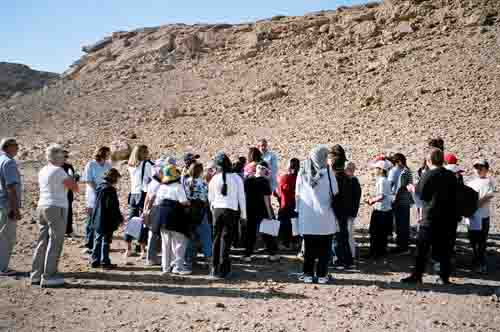
Above
- 5th form in Fossil Valley, reviewing safety rules
and checking fossil identification handout
Right – Treasures are everywhere.
This large stone with a small crystal embedded in
it has found a friend. |
|
|
|
| We moved on to Jimi
oasis where the ancient technique of building with mud-bricks
has been used to reconstruct several homes and structures in
the oasis. This was the official lunch-stop, so everyone took
some quiet time. After lunch, a short talk about the history
of the site was given, how the people lived here and how they
built their homes of mud. Parrots and bee-eaters added to the
excitement.
|
| The students clambered
over this two-storey building which is narrower at the
top than at the bottom, normal for these old buildings,
but unlike today’s solid rectangular buildings.
The brick factory is right on-site, and the students were
suitably impressed with the system of manufacture. The
mud-bricks are still evident in the building as the final
layer of mud and straw (sarooj) has not yet been applied.
Even the students noticed how much cooler it was inside
the house than out. |
A mud-brick two-storey building
in Jimi oasis.
photo by Will Moore |
|
|
|
|
----------------------------------------------------------------------------------------------------------------------------------
| The ENHG
Newsletter…
January, 2005–
Issue #224 |
|
Al
Ain English Speaking School – Fifth Form Field Trip
cont…
The next,
and final stop for the day was the Hili Archeological Park
where the students viewed the tombs at Hili 8. Here, as this
is an active archeological site, the students were careful
not to disturb anything. They were able to look into the grand
tomb and see the difference between reconstructed stone-work
and natural 5000 year old work. It was a VERY BUSY day. And
so we returned to the school just after 4:00.
|
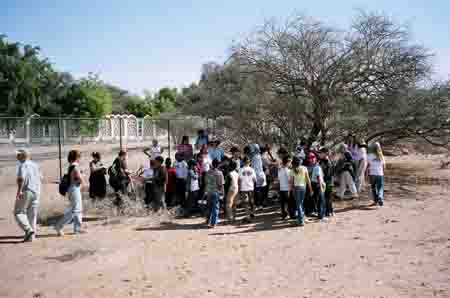
Gathered in the shade
for the talk at Hili 8 |
|
|
|
Tuesday morning, we headed out to Khutwa
village in the Hajar Mountains of Oman. Two tours were
conducted in the morning for each of the two groups of
students. Group 1 toured the oasis first and the archeological
sites next, while Group 2 did the same in reverse order.
The oasis offered up a great variety of useful plants:
henna, guava, date palm, orange and lemon trees, animal
fodder, papaya, and mango were identified. In the fields,
lettuce, radish, mustard, corn, red chili, rocket, and
onion were noted. The falaj system of irrigating the fields
was studied and the students |
|
| were
able to use an Abney leveling instrument to check the slope
of the water troughs. |

The students learn about the sun-clock,
shadows and how water was allocated in Khutwa village.
|
|
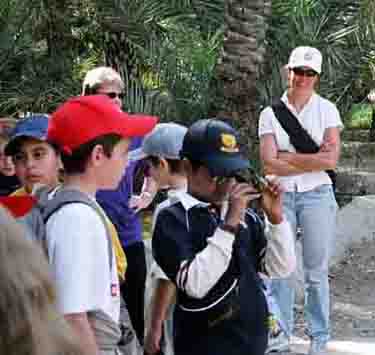
The students took
turns examining the Abney level, a more modern inst-rument,
for calculating the slope of the land. |
|
|
The second tour took the students to the old village
where electricity (and thus a/c) was unknown. They examined
the old stone “homes,” and imagined living there.
Next was the ancient copper smelting site where hand-prints
from thousands of years ago have been preserved in the mud bricks
they covered the kiln with. “How did it work?” “Where
did they get the copper?” “Who were the people that
did this?” All sorts of excellent questions were posed
and discussed. To date, no actual copper ore source has been
found. These two tours were followed by a lunch break in the
shade of the old mango trees at the center of the village. The
students were careful not to litter and impressed the ENHG members
with their conscientiousness (spell that without looking if
you can!). Then came the best part of all. |
|
|
--------------------------------------------------------------------------------------------------------------------------------
--------------------------------------------------------------------------------------------------------------------------------
| The ENHG
Newsletter…
January, 2005–
Issue #224 |
|
Article
& photos by Louise Lambert
We set off early to reach Bab Al-Yemen.
My friend a Sri Lankan Muslim in Western clothing, myself
a non-Muslim Canadian in full hijjab are pointed to a bright
yellow taxi. Our driver turns to grin at us very impressed
with himself at the reported age of 16 – I’m thinking
more like 13 – as the owner and – gasp! –
driver of this jazzed up car. Qu’ranic verses printed
on a CD disc hang on the rear view mirror while plush red
“I love you Sweetie” pillows adorned with frills
cushion us in the back seat. A 30’s style Charleston
woman is decaled in red on the inside of each window while
a golden tasseled plush dash cover traps dust and yellows
in the sun. This not only requires a photo, as our driver
happily obliges us by letting go of the steering wheel to
properly pose, but also deserves the opening of the top flap
of my burqa to clearly see if the comedic value is warranted.
It is. And the sunlight is much brighter than it appears.
|
 A Sanaa taxi driver in his home-away-from-home
A Sanaa taxi driver in his home-away-from-home |
|
|
I chose to wear the burqa because
I saw no women without it and I did not want to stand
out in any way. But most of all, I wanted to be afforded
the same respect and treatment Yemeni women received.
I suppose that also meant I’d signed up for sweating
all day, having trouble breathing and getting very,
very flat hair.
Our arrival is greeted
by very few, it being the second day of Eid. Bab Al-Yemen,
literally the doorof Yemen is indeed the opening to
a living history where architect-ture, people, prayer,
food community and celebration solemnly come together.
Most old cities are abandoned and replaced by tourist
postcard and doughnut shops,
|
|
but old Sana’a is for
the Yemenis and instead visitors are watched like bears
in a cage. The feeling is pleasant and ranges from the
least frequent response of indifference to Salaam Aleuykum,
Eid Mubarak!, Keif Halekum and please won’t you
meet my family, father, grandfather, son?
Families begin to pour
slowly into the streets after prayer. Every man and boy
sporting the best and biggest affordable jambiya strapped
on by satin and sequin belts of bright green, the color
of Islam. The jambiyya is the traditional curved dagger
being the symbol of Yemen and Oman. Little girls hang
on their father’s hand, proud as prom queens (Cinderella
comes to mind) in pink puffy dresses, tiaras and clear
plastic shoes. The tac-tac-tac of new Eid shoes against
the cobblestone draws my attention to curious eyes and
black henna swirls across little fingers, knuckles, wrists
and finally twisting up past the elbows. Fathers and their
children walk hand in hand, sometimes ten abreast in the
narrow streets greeting everyone as they pass, including
us - says a |
|
 The author in burqa and sheila
The author in burqa and sheila
|
|
lot about family values.
Old Sana’a is a World Heritage
site protected by UNESCO and is the largest completely preserved
medina in the Arab World. Short and narrow carved wooden doors
seem to hold up six to seven story tower houses made of mud
and brick and baked as hard as clay over the centuries. Large
families live in these separated by different floors for privacy
but congregating on common floors to eat and socialize. Homes,
shops and restaurants are flush with the streets already crowded
with Eid revelers and the toots of slow moving cars forcing
medina dwellers onto a narrow or non-existent sidewalk. As I
walk behind my friend, cars creep by and gentle hands offer
us raisins and coins. We feel like intruders on a very special
day yet are somehow brought into the fold seamlessly and with
the grandest smiles and with a deep appreciation of our efforts.
We take a break in the only open restaurant we’ve seen
and only men are seated inside. Unsure of the protocol, we ask
permission for me to enter only to be greeted with Of course!,
Come in and Eid Mubarak! Warm, folded, Yemeni bread (about the
size and thickness of a closed newspaper) is brought over with
a metal dish of hot eggs and two cups of steaming and (very!!)
sugared tea. |
|
|
-----------------------------------------------------------------------------------------------------------------------------
| The ENHG
Newsletter…
January, 2005–
Issue #224 |
|
From behind
the burqa, cont...
I could almost taste
the cool air on my face but decide to do like other burqa
wearing women and eat with my fingers lifting the veil enough
to put food in my mouth without showing my face. It works
well except that I drop some egg in the folds of my sheil’a
and can smell breakfast all day.
We continue to walk on in this old city noticing the friendliness
of people, the laughter of children, the care of the elderly
family members flanked by younger boys as protection and
these silver jambiyyas reflecting and glistening in the
sunlight.
I open the top flap again
once we are on a bridge and look out over the city view
of mud houses, mosque minarets, mountains and clean air
and sky. Things have not changed here and peacefulness wafts
everywhere. For a Westerner, even one behind a burqa, that
is a breath of fresh air.
|
 A view of Sanaa, Yemen
A view of Sanaa, Yemen |
RECYCLING PROJECT
The wheels of recycling run slow but sure. Due
to other major commitments the recycling sign
has been held up again, but should be ready
before Feb. 10. We have already filled the paper
bin once and anticipate an official opening
ceremony in February – sometime. Thank
you for your patience. As soon as everything
is in place, we will send out notices. All paper
and metal (cans) are acceptable. Sorry, no glass
or plastic yet.
|
|
|
 Eid dress for boys is important in Yemen.
Eid dress for boys is important in Yemen. |
|
| IBRI
/ NIZWA TRIP #2 – March 31 – April 1, 2005
The committee has decided to have the second
trip to Ibri / Nizwa on the weekend of March 31 – April
1 (no – this is not an early April fool’s joke!).
The plan is to spend Wednesday evening in Ibri and to have
one group go to the Al Ayn Necropolis site (and possibly on
to Sent) then on to Tabrin, Bahla, wadi Gul, and Talath. If
enough interest is shown (by email) then a second group will
go up Jebel Shams and do the cliff walk. This could take place
either on Thursday or Friday, depending on what people want.
Thursday evening the group(s) will meet up in Nizwa and on
Friday the plan is to go to the Nizwa souq, Mannah, Misfa
and Al Hamra before returning to Al Ain late in the day. Please
contact Will at dreigo@eim.ae to confirm for the trip &
to indicate your interests.
|
The
frog does not drink up the pond in which he lives. ~Native
American Proverb |
|
|
|
---------------------------------------------------------------------------------------------------------------------------------
| The ENHG
Newsletter…
January, 2005–
Issue #224 |
|
The Sahara,
its diverse wildlife and major habitats.
|
A presentation by John
Newby – article
by Will Moore
We are indeed
lucky, here in Al Ain, so far from it all, yet able to attend
presentations put on by such highly experienced people as
Mr. John Newby who after some eight years in Chad as a volunteer
wildlife biologist, established an 80,000 km² Aïr
and Ténéré National Nature Reserve
and World Heritage Site in Niger. In1991 John was head of
WWF International’s Africa & Madagascar Programme,
and in 1998 WWF’s Endangered Species Programme. After
28 years with WWF he accepted a job with ERWDA, in Abu Dhabi,
in 2002 to head up the Terrestrial Environment Research
Centre. John has published widely and was decorated on two
occasions by governments in Niger for services to nature
conservation. He has been made an Officer in the Order of
the Golden Ark by HH Prince Bernhard of the Netherlands.
He believes, as did G. W. Murray, a British Surveyor working
in Egypt, that “a day spent out of the desert is a
day wasted”.
His presentation on Tuesday, January 25th, at the Intercon
Hotel here in Al Ain was well received by a crowd of about
50. I think it was the width and depth of the presentation
that impressed me the most. He began with overviews and
worked right down to the individual species, environments
and details of interest.
|
|
His point about how the pressures almost never go away
- even when wildlife has been threatened with near extinction,
rehabilitation projects have been initiated complete with
public awareness programs, and then reintroduction to
the wild has taken place – as with the Omani oryx
– even then, people forget and within a few short
years the rehabilitated wildlife is under threat anew,
if not extinct – this was the most telling point
of the evening. How can we overcome the short term memories
of people who should know better? |
 Scimitar-horned Oryx
Scimitar-horned Oryx |
|
|
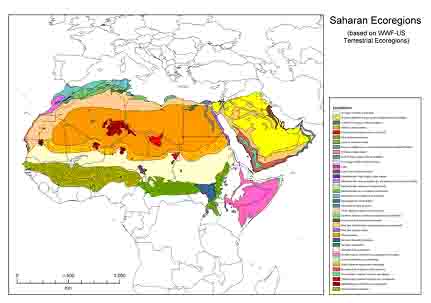 The various ecoregions of the Sahara
and Saudi peninsula
The various ecoregions of the Sahara
and Saudi peninsula |
|
He spoke of rainfall and plants and the forces that cause
changes in their distribution. Rainfall, of course is
still beyond our control, but reducing pressures on plants,
such as grazing or harvesting forests, is within our control.
Broader reforestation and replanting programs are needed.
It is a massive task. But one step at a time does the
deed. John’s message needs to be heard across the
land and water. For the members of the Emirates Natural
History Group, I would like to thank him for sharing his
insights and his knowledge of this region. I only hope
that governments make more funds available to him to continue
his good work. |
|
Just
a reminder -
the 5th Annual Al Ain Classical
Music Festival is set for March 2nd, 3rd, & 4th.
Watch advance notice at the Intercon Hotel. As you know,
the ENHG holds its bi-monthly meetings at the Intercon,
and we have conducted local tours for their guests for
this event (and others) for the past two or three years
by way of saying thank you. So if you want to get involved
and help support this event, volunteer to lead a couple
of groups to a place you know of that is of interest
to natural history types.
|
|
|
|
---------------------------------------------------------------------------------------------------------------------------------
| The ENHG
Newsletter…
January, 2005–
Issue #224 |
|
Weekly
Friday Outings
This
past month, the ENHG has conducted tours:
to Subaitha ( Jan. 7th) - What has Subaitha got to offer?
A spectacular gorge. A lovely oasis. A largely abandoned
village with mud brick houses and a watch tower. A falaj
which hugs the cliff-face and ends at deep pools which may
be swimmable. Some copper smelting sites. Fruit trees in
the oasis, wild flowers in the wadi. Insects, birds, geckos,
toads, wadi fish, often a donkey. Spectacular photo-opportunities.
A report on one of last year's trips may be found at http://www.enhg.org/gallery/subaitna/subait.htm.
to Jebeeb
(Jan. 14th), looking for more artefacts before the new developments
bury them, a few pieces were found, but not that hoped-for
ancient gold coin, etc.
to the desert
between Abu Dhabi and Al Ain, looking for the old camel
caravan stopovers (Jan. 21st) - Years ago, camel caravans
traveled routinely from Al Ain to Abu Dhabi, the trip taking
up to eight days. Caravans would stop at wells along the
route and at other locations. Some small communities are
now established where these wells were located, as is the
case on the Al Ain – Dubai highway. As a result, all
traces of the caravan stops have been lost under new development.
One of the sites was known among members of the Abu Dhabi
chapter as Site One, a spot on the north side of the Al
Ain – Abu Dhabi highway about 33 km from the Mafraq
bridge. Site One now appears to be lost owing to farm development.
– sadly, no sign was found of any caravan sites.
And to the
two abandoned villages back of Khutwa (Jan. 28th), these
are very interesting sites. What with the winter rains,
the terraces were all green with small plants. There was
an opportunity to swim and really enjoy nature as well.
There is a write up on these sites in the September 2004
newsletter.
As noted
by Jerry, Comet Machholz passed overhead – and was
seen by at least one member of the group – a planned
moonlit walk was cancelled due to inclement weather (no,
I do not mean that the temperature fell below 20 degrees
– it was cold out, and there was a real threat of
cloud or fog moving in while the group was out!)
As
noted by Geoff S., Agar Wood or Oud (they are one and the
same) and Sandalwood
Following web sites will give you a good background on the
scientific names for what is known as Oud or Agar Wood.
They are followed by a reference for Sandalwood, a different
species produced by an entirely different plant type. Agarwood
is produced in a large forest tree and Sandalwood is a scrappy
small tree or large shrub.
Agarwood contains a resin that is produced by the tree's
defence system when attacked by certain fungi. Only small
parts of the tree will be so affected and carry the resin,
hence the scarcity and high price of Agarwood.
Sandalwood, on the other hand, offers all its wood but it
is slow growing, relatively rare and similarly expensive.
|
A THIRD WAY TO MUSCAT?
For those who are bored with the usual two routes south
to Muscat (the Nizwa road & the coast road), there has
always been an exciting alternative. We hope to bring you
more details of this new route in next month’s issue.
|
|
|
|




